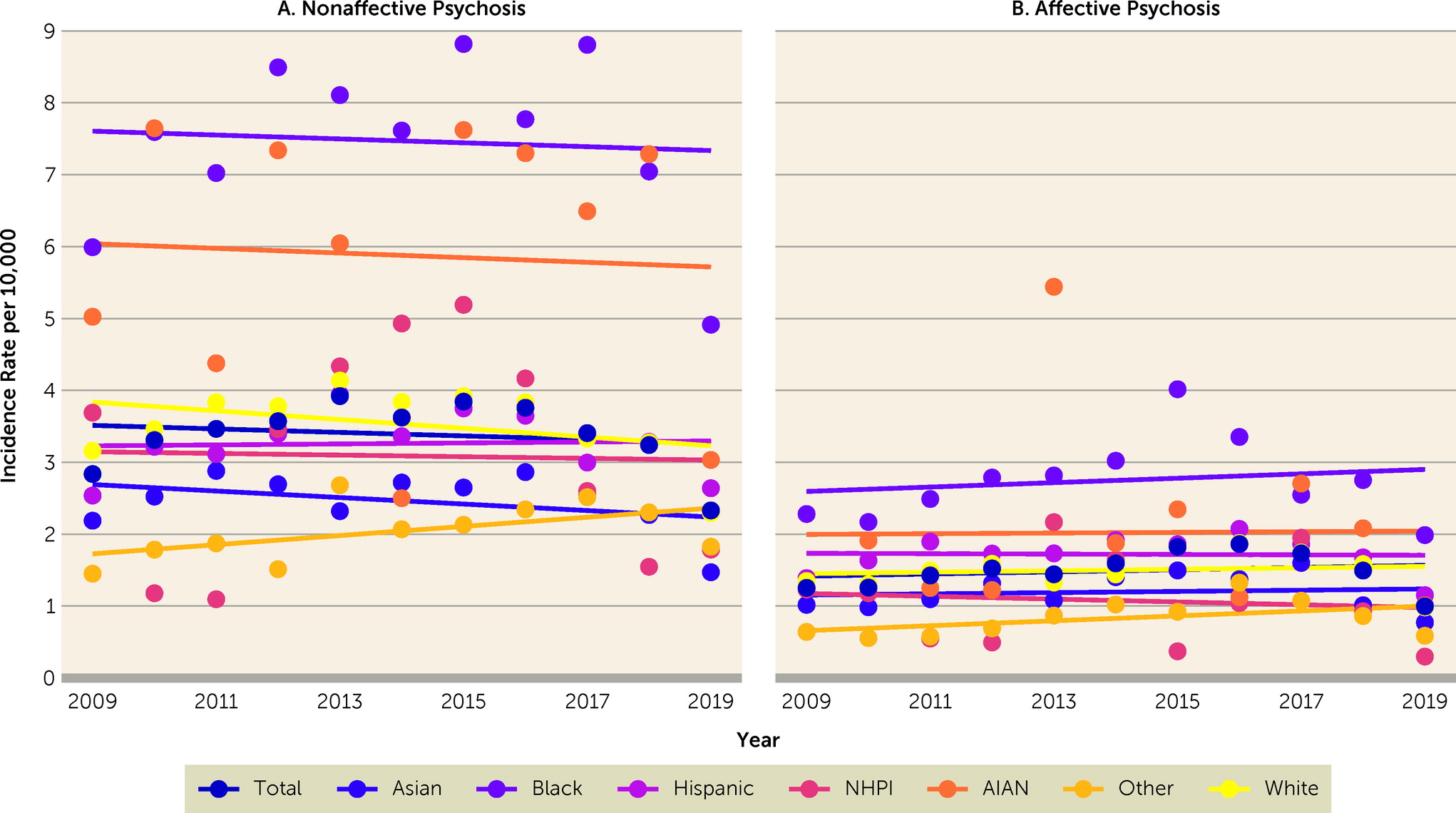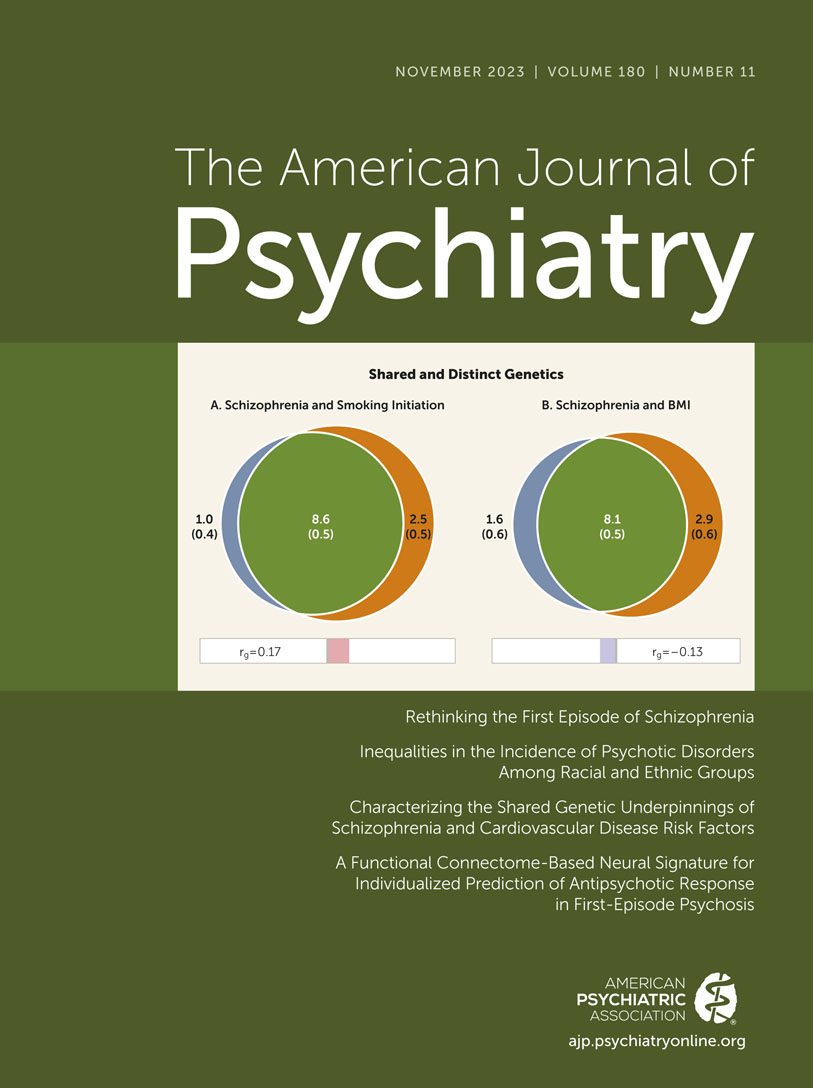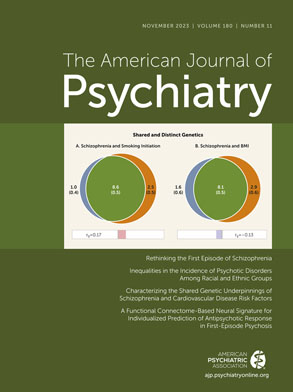Inequalities in the Incidence of Psychotic Disorders Among Racial and Ethnic Groups
Abstract
Objective:
Method:
Results:
Conclusions:
Methods
Data Source
Measures
Statistical Analysis
Results
Sample Characteristics
| Characteristic | Nonaffective Psychotic Disorders | Affective Psychotic Disorders | ||||||
|---|---|---|---|---|---|---|---|---|
| N | % | Person-Years | Rateb | N | % | Person-Years | Rateb | |
| Total | 13,303 | 100.0 | 37,413,137 | 3.56 | 5,888 | 100.0 | 37,440,577 | 1.57 |
| Age (years) | ||||||||
| <18 | 4,253 | 32.0 | 10,418,075 | 4.08 | 1,664 | 28.3 | 10,427,903 | 1.60 |
| 18–24 | 1,237 | 9.3 | 2,227,438 | 5.55 | 408 | 6.9 | 2,230,750 | 1.83 |
| 25–34 | 1,472 | 11.1 | 5,443,500 | 2.70 | 808 | 13.7 | 5,445,871 | 1.48 |
| 35–44 | 1,422 | 10.7 | 5,446,530 | 2.61 | 925 | 15.7 | 5,448,618 | 1.70 |
| 45–54 | 1,439 | 10.8 | 5,633,171 | 2.55 | 967 | 16.4 | 5,634,873 | 1.72 |
| 55–64 | 1,078 | 8.1 | 4,510,596 | 2.39 | 638 | 10.8 | 4,512,254 | 1.41 |
| ≥65 | 2,402 | 18.1 | 3,733,828 | 6.43 | 478 | 8.1 | 3,740,309 | 1.28 |
| Sex | ||||||||
| Female | 6,589 | 49.5 | 19,383,996 | 3.40 | 3,634 | 61.7 | 19,395,199 | 1.87 |
| Male | 6,714 | 50.5 | 18,029,141 | 3.72 | 2,254 | 38.3 | 18,045,378 | 1.25 |
| Race/ethnicity | ||||||||
| Asian | 1,638 | 12.3 | 6,705,168 | 2.44 | 807 | 13.7 | 6,708,588 | 1.20 |
| Black | 2,020 | 15.2 | 2,700,891 | 7.48 | 746 | 12.7 | 2,705,711 | 2.76 |
| Hispanic | 2,498 | 18.8 | 7,756,347 | 3.22 | 1,316 | 22.4 | 7,760,343 | 1.70 |
| NHPI | 84 | 0.6 | 275,723 | 3.05 | 29 | 0.5 | 275,898 | 1.05 |
| AIAN | 111 | 0.8 | 176,624 | 6.28 | 38 | 0.6 | 176,858 | 2.15 |
| Other | 968 | 7.3 | 2,980,047 | 3.25 | 389 | 6.6 | 2,982,220 | 1.30 |
| White | 5,984 | 45.0 | 16,818,338 | 3.56 | 2,563 | 43.5 | 16,830,960 | 1.52 |
| Marital status | ||||||||
| Divorced or separated | 1,164 | 8.7 | 1,695,687 | 6.86 | 583 | 9.9 | 1,697,845 | 3.43 |
| Married or partner | 3,164 | 23.8 | 13,821,953 | 2.29 | 1,897 | 32.2 | 13,826,626 | 1.37 |
| Single | 7,061 | 53.1 | 13,929,241 | 5.07 | 2,851 | 48.4 | 13,945,222 | 2.04 |
| Widowed | 1,152 | 8.7 | 1,448,223 | 7.95 | 249 | 4.2 | 1,451,345 | 1.72 |
| Unknown | 762 | 5.7 | 6,518,032 | 1.17 | 308 | 5.2 | 6,519,539 | 0.47 |
| Employment status | ||||||||
| Employed | 2,550 | 19.2 | 10,670,394 | 2.39 | 1,526 | 25.9 | 10,674,288 | 1.43 |
| Retired | 3,094 | 23.3 | 5,299,053 | 5.84 | 983 | 16.7 | 5,306,191 | 1.85 |
| Student | 963 | 7.2 | 1,490,542 | 6.46 | 469 | 8.0 | 1,492,484 | 3.14 |
| Unemployed | 5,173 | 38.9 | 10,002,378 | 5.17 | 2,208 | 37.5 | 10,013,925 | 2.20 |
| Unknown | 1,523 | 11.4 | 9,950,769 | 1.53 | 702 | 11.9 | 9,953,688 | 0.71 |
| Depressive disorder | ||||||||
| No | 5,048 | 37.9 | 30,891,858 | 1.63 | 622 | 10.6 | 30,908,375 | 0.20 |
| Yes | 8,255 | 62.1 | 6,521,280 | 12.66 | 5,266 | 89.4 | 6,532,202 | 8.06 |
| Bipolar disorder | ||||||||
| No | 8,821 | 66.3 | 36,729,362 | 2.40 | 3,240 | 55.0 | 36,749,246 | 0.88 |
| Yes | 4,482 | 33.7 | 683,775 | 65.55 | 2,648 | 45.0 | 691,331 | 38.30 |
| Anxiety disorder | ||||||||
| No | 3,174 | 23.9 | 26,152,992 | 1.21 | 658 | 11.2 | 26,161,237 | 0.25 |
| Yes | 10,129 | 76.1 | 11,260,146 | 9.00 | 5,230 | 88.8 | 11,279,339 | 4.64 |
| Personality disorder | ||||||||
| No | 11,049 | 83.1 | 36,772,982 | 3.00 | 4,438 | 75.4 | 36,796,963 | 1.21 |
| Yes | 2,254 | 16.9 | 640,156 | 35.21 | 1,450 | 24.6 | 643,613 | 22.53 |
| Alcohol use disorder | ||||||||
| No | 10,487 | 78.8 | 35,818,985 | 2.93 | 4,598 | 78.1 | 35,840,727 | 1.28 |
| Yes | 2,816 | 21.2 | 1,594,152 | 17.66 | 1,290 | 21.9 | 1,599,849 | 8.06 |
| Drug use disorder | ||||||||
| No | 8,387 | 63 | 35,871,730 | 2.34 | 3,919 | 66.6 | 35,888,836 | 1.09 |
| Yes | 4,916 | 37 | 1,541,407 | 31.89 | 1,969 | 33.4 | 1,551,741 | 12.69 |
| Posttraumatic stress disorder | ||||||||
| No | 9,115 | 68.5 | 32,408,937 | 2.81 | 3,155 | 53.6 | 32,431,175 | 0.97 |
| Yes | 4,188 | 31.5 | 5,004,200 | 8.37 | 2,733 | 46.4 | 5,009,402 | 5.46 |
| Pervasive developmental disorder | ||||||||
| No | 12,736 | 95.7 | 37,139,758 | 3.43 | 5,735 | 97.4 | 37,165,314 | 1.54 |
| Yes | 567 | 4.3 | 273,380 | 20.74 | 153 | 2.6 | 275,262 | 5.56 |
Incidence of Psychotic Disorder Diagnoses

Association Between Demographic Characteristics and Incident Psychotic Disorder Diagnoses
| Characteristic | Nonaffective Psychotic Disorders | Affective Psychotic Disorders | ||||||||||
|---|---|---|---|---|---|---|---|---|---|---|---|---|
| Model 1 | Model 2 | Model 1 | Model 2 | |||||||||
| Hazard Ratio | 95% CI | p | Hazard Ratio | 95% CI | p | Hazard Ratio | 95% CI | p | Hazard Ratio | 95% CI | p | |
| Race/ethnicity | ||||||||||||
| Asian | 0.72 | 0.68, 0.76 | <0.001 | 0.78 | 0.74, 0.83 | <0.001 | 0.77 | 0.71, 0.83 | <0.001 | 0.84 | 0.78, 0.92 | <0.001 |
| Black | 2.13 | 2.02, 2.24 | <0.001 | 1.73 | 1.64, 1.82 | <0.001 | 1.76 | 1.62, 1.91 | <0.001 | 1.43 | 1.32, 1.56 | <0.001 |
| Hispanic | 0.91 | 0.87, 0.96 | <0.001 | 0.85 | 0.81, 0.90 | <0.001 | 1.09 | 1.02, 1.16 | 0.016 | 1.01 | 0.94, 1.08 | 0.786 |
| NHPI | 0.85 | 0.69, 1.06 | 0.152 | 0.82 | 0.66, 1.02 | 0.074 | 0.69 | 0.48, 0.99 | 0.046 | 0.67 | 0.47, 0.97 | 0.035 |
| AIAN | 1.85 | 1.53, 2.23 | <0.001 | 1.67 | 1.38, 2.02 | <0.001 | 1.38 | 1.00, 1.90 | 0.048 | 1.26 | 0.91, 1.74 | 0.159 |
| Other | 0.92 | 0.86, 0.99 | 0.018 | 1.03 | 0.96, 1.10 | 0.453 | 0.86 | 0.77, 0.96 | 0.006 | 1.00 | 0.90, 1.12 | 0.947 |
| Whiteb | 1.00 | | | 1.00 | | | 1.00 | | | 1.00 | | |
| Marital status | ||||||||||||
| Divorced or separated | 1.34 | 1.24, 1.44 | <0.001 | 1.16 | 1.08, 1.25 | <0.001 | 1.52 | 1.38, 1.69 | <0.001 | 1.31 | 1.18, 1.45 | <0.001 |
| Married or with a partner | 0.45 | 0.43, 0.48 | <0.001 | 0.43 | 0.40, 0.45 | <0.001 | 0.62 | 0.57, 0.66 | <0.001 | 0.56 | 0.52, 0.60 | <0.001 |
| Singleb | 1.00 | | | 1.0 | | | 1.0 | | | 1.00 | | |
| Widowed | 1.11 | 1.02, 1.20 | 0.015 | 0.95 | 0.87, 1.03 | 0.211 | 0.91 | 0.78, 1.06 | 0.229 | 0.75 | 0.64, 0.88 | <0.001 |
| Unknown | 0.23 | 0.22, 0.25 | <0.001 | 0.33 | 0.30, 0.35 | <0.001 | 0.23 | 0.20, 0.25 | <0.001 | 0.34 | 0.30, 0.38 | <0.001 |
| Employment status | ||||||||||||
| Employedb | 1.0 | | | 1.0 | | | 1.0 | | | 1.00 | | |
| Retired | 2.52 | 2.32, 2.73 | <0.001 | 2.40 | 2.21, 2.61 | <0.001 | 2.26 | 2.02, 2.54 | <0.001 | 2.21 | 1.97, 2.48 | <0.001 |
| Student | 4.38 | 4.02, 4.77 | <0.001 | 3.82 | 3.51, 4.16 | <0.001 | 5.04 | 4.46, 5.69 | <0.001 | 4.44 | 3.94, 5.02 | <0.001 |
| Unemployed | 3.40 | 3.21, 3.60 | <0.001 | 3.52 | 3.32, 3.73 | <0.001 | 2.85 | 2.64, 3.08 | <0.001 | 2.96 | 2.74, 3.19 | <0.001 |
| Unknown | 0.61 | 0.57, 0.65 | <0.001 | 0.74 | 0.69, 0.79 | <0.001 | 0.51 | 0.47, 0.56 | <0.001 | 0.67 | 0.61, 0.74 | <0.001 |
| Health services use (past year) | ||||||||||||
| <1 visitb | 1.00 | | | 1.00 | | | 1.00 | | | 1.00 | | |
| ≥1 visit | 1.19 | 1.13, 1.25 | <0.001 | 0.95 | 0.90, 1.01 | 0.075 | 1.67 | 1.52, 1.83 | <0.001 | 1.31 | 1.19, 1.43 | <0.001 |
| Neighborhood deprivation index | 1.20 | 1.18, 1.22 | <0.001 | 1.11 | 1.09, 1.13 | <0.001 | 1.18 | 1.15, 1.21 | <0.001 | 1.10 | 1.07, 1.13 | <0.001 |
Associations Between Other Psychiatric Disorders and Incident Psychotic Disorder Diagnoses
| Mental Disorder | Model 1 | Model 2 | Model 3 | ||||||
|---|---|---|---|---|---|---|---|---|---|
| Odds Ratio | 95% CI | p | Odds Ratio | 95% CI | p | Odds Ratio | 95% CI | p | |
| Depressive disorder | 15.11 | 14.62, 15.62 | <0.001 | 3.00 | 2.88, 3.12 | <0.001 | 2.98 | 2.86, 3.10 | <0.001 |
| Bipolar disorder | 38.58 | 37.35, 39.86 | <0.001 | 7.54 | 7.25, 7.84 | <0.001 | 7.67 | 7.37, 7.98 | <0.001 |
| Anxiety disorder | 13.31 | 12.82, 13.81 | <0.001 | 2.58 | 2.46, 2.69 | <0.001 | 2.65 | 2.54, 2.77 | <0.001 |
| Personality disorder | 16.94 | 16.28, 17.63 | <0.001 | 1.48 | 1.41, 1.55 | <0.001 | 1.49 | 1.42, 1.56 | <0.001 |
| Alcohol use disorder | 8.00 | 7.70, 8.31 | <0.001 | 1.15 | 1.10, 1.20 | <0.001 | 1.19 | 1.13, 1.24 | 0.035 |
| Drug use disorder | 16.87 | 16.34, 17.41 | <0.001 | 3.26 | 3.13, 3.39 | <0.001 | 3.07 | 2.94, 3.20 | <0.001 |
| Posttraumatic stress disorder | 4.93 | 4.77, 5.09 | <0.001 | 1.20 | 1.16, 1.24 | <0.001 | 1.17 | 1.13, 1.21 | <0.001 |
| Pervasive developmental disorder | 4.83 | 4.45, 5.25 | <0.001 | 1.97 | 1.80, 2.16 | <0.001 | 1.88 | 1.71, 2.06 | <0.001 |
Associations Between Incident Psychotic Disorder Diagnoses and Negative Outcomes
| Outcome | Psychosis | | | | | | | | | | |||
|---|---|---|---|---|---|---|---|---|---|---|---|---|---|
| No | Yes | Model 1 | Model 2 | Model 3 | |||||||||
| N | % | N | % | Odds Ratio | 95% CI | p | Odds Ratio | 95% CI | p | Odds Ratio | 95% CI | p | |
| Accident | 10,053 | 0.2 | 91 | 0.5 | 2.48 | 2.02, 3.06 | <0.001 | 1.16 | 0.94, 1.43 | 0.174 | 1.09 | 0.88, 1.35 | 0.411 |
| Suicide | 3,213 | 0.1 | 100 | 0.6 | 10.91 | 8.93, 13.33 | <0.001 | 2.51 | 2.03, 3.10 | <0.001 | 2.65 | 2.15, 3.28 | <0.001 |
| Homicide | 1,059 | 0.02 | 9 | 0.1 | 2.81 | 1.46, 5.42 | 0.002 | 1.31 | 0.66, 2.59 | 0.440 | 1.02 | 0.52, 2.03 | 0.948 |
| Premature death | 127,015 | 2.1 | 1,067 | 6.1 | 2.80 | 2.62, 2.99 | <0.001 | 1.53 | 1.43, 1.63 | <0.001 | 1.30 | 1.22, 1.39 | <0.001 |
| HIV | 13,800 | 0.2 | 110 | 0.6 | 3.53 | 2.92, 4.27 | <0.001 | 0.98 | 0.81, 1.19 | 0.863 | 0.87 | 0.71, 1.05 | 0.150 |
| STI | 299,632 | 5.0 | 1,552 | 8.9 | 2.10 | 1.99, 2.22 | <0.001 | 0.98 | 0.93, 1.04 | 0.552 | 0.99 | 0.94, 1.05 | 0.814 |
| Stroke | 250,012 | 4.2 | 2,361 | 13.5 | 3.39 | 3.22, 3.58 | <0.001 | 1.94 | 1.84, 2.04 | <0.001 | 1.64 | 1.55, 1.72 | <0.001 |
| CAD | 246,856 | 4.1 | 1,555 | 8.9 | 2.00 | 1.89, 2.13 | <0.001 | 1.28 | 1.20, 1.36 | <0.001 | 1.11 | 1.04, 1.18 | 0.001 |
| MI | 114,415 | 1.9 | 760 | 4.3 | 1.93 | 1.78, 2.08 | <0.001 | 1.30 | 1.20, 1.41 | <0.001 | 1.13 | 1.05, 1.23 | 0.002 |
| Obesity | 1,833,888 | 30.7 | 8,306 | 47.4 | 2.31 | 2.24, 2.39 | <0.001 | 1.13 | 1.09, 1.17 | <0.001 | 1.10 | 1.06, 1.14 | <0.001 |
| Diabetes | 519,611 | 8.7 | 2,577 | 14.7 | 1.80 | 1.72, 1.88 | <0.001 | 1.36 | 1.30, 1.43 | <0.001 | 1.15 | 1.09, 1.20 | <0.001 |
| Smoking | 1,344,538 | 22.5 | 6,066 | 34.7 | 2.10 | 2.03, 2.18 | <0.001 | 0.76 | 0.73, 0.79 | <0.001 | 0.78 | 0.75, 0.81 | <0.001 |
| Utilization | 5,039,059 | 84.3 | 15,555 | 88.9 | 1.37 | 1.31, 1.44 | <0.001 | 0.50 | 0.48, 0.53 | <0.001 | 0.44 | 0.42, 0.47 | <0.001 |
Discussion
Main Findings
Interpretation
Strengths and Limitations
Conclusions
References
Information & Authors
Information
Published In
History
Keywords
Authors
Competing Interests
Funding Information
Metrics & Citations
Metrics
Citations
Export Citations
If you have the appropriate software installed, you can download article citation data to the citation manager of your choice. Simply select your manager software from the list below and click Download.
For more information or tips please see 'Downloading to a citation manager' in the Help menu.
View Options
View options
PDF/EPUB
View PDF/EPUBLogin options
Already a subscriber? Access your subscription through your login credentials or your institution for full access to this article.
Personal login Institutional Login Open Athens loginNot a subscriber?
PsychiatryOnline subscription options offer access to the DSM-5-TR® library, books, journals, CME, and patient resources. This all-in-one virtual library provides psychiatrists and mental health professionals with key resources for diagnosis, treatment, research, and professional development.
Need more help? PsychiatryOnline Customer Service may be reached by emailing [email protected] or by calling 800-368-5777 (in the U.S.) or 703-907-7322 (outside the U.S.).

